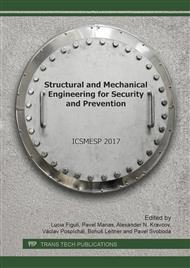[1]
A. Coffield and H. Adeli. An investigation of the effectiveness of the framing systems in steel structures subjected to blast loading. Journal of Civil Engineering and Management, 20(6): 767- 777, (2014).
DOI: 10.3846/13923730.2014.986667
Google Scholar
[2]
B.D. Ellis, B.P. DiPaolo, D.L. McDowell, and M. Zhou. Experimental investigation and multiscale modeling of ultra-high-performance concrete panels subject to blast loading. International Journal of Impact Engineering, 69: 95-103, (2014).
DOI: 10.1016/j.ijimpeng.2013.12.011
Google Scholar
[3]
H. Aoude, F.P. Dagenais, R.P. Burrell, and M. Saatcioglu. Behavior of ultra-high performance fiber reinforced concrete columns under blast loading. International Journal of Impact Engineering, 80: 185-202, (2015).
DOI: 10.1016/j.ijimpeng.2015.02.006
Google Scholar
[4]
R. Castedo, P. Segarra, A. Ala˜non, L.M. Lopez, A.P. Santos, and J.A. Sanchidrian. Air blast resistance of full-scale slabs with different compositions: Numerical modeling and field validation. International Journal of Impact Engineering, 86: 145-156, 2015. 50 Structural and Mechanical Engineering for Security and Prevention.
DOI: 10.1016/j.ijimpeng.2015.08.004
Google Scholar
[5]
Y. Shi and M.G. Stewart. Damage and risk assessment for reinforced concrete wall panels subjected to explosive blast loading. International Journal of Impact Engineering, 85: 5-19, (2015).
DOI: 10.1016/j.ijimpeng.2015.06.003
Google Scholar
[6]
CINAMIL. http: /academiamilitar. pt/investigacao-e-inovacao/projetos. html. Accessed: 2017-03-31.
Google Scholar
[7]
R. Gi˜ao, V. L´ucio, C. Chastre, and A. Bras. UFRG - unidirectional fibre reinforced grout as strengthening material for reinforced concrete structures. In J. Barros, editor, BEFIB2012 - Fibre reinforced concrete, pages 1-12, Guimar˜aes, 2012. University of Minho.
DOI: 10.1016/j.conbuildmat.2017.01.131
Google Scholar
[8]
W.E. Baker, P.A. Cox, J.J. Kulesz, R.A. Strehlow, and P.S. Westine. Explosion Hazards and Evaluation. Number 5 in Fundamental Studies in Engineering. Elsevier Science, (1983).
Google Scholar
[9]
G. F. Kinney and K. J. Graham. Explosive Shocks in Air. Springer Berlin Heidelberg, 2nd edition, (1985).
Google Scholar
[10]
C.E. Needham. Blast Waves. Shock Wave and High Pressure Phenomena. Springer Berlin Heidelberg, (2010).
Google Scholar
[11]
U.S. Army Corps of Engineers. Methodology Manual for the Single-Degree-of-Freedom Blast effects Design Spreadsheets, pdc tr-06-01 edition, September (2008).
Google Scholar
[12]
Applied Science International, Durham, NC. Extreme Loading for Structures V3. 1. Theoretical Manual, (2013).
Google Scholar
[13]
H. Tagel-Din and K. Meguro. Applied element simulation for collapse analysis of structures. Bull. of Earthquake Resistant Struct. Res. Ctr, pages 113-123, (1999).
Google Scholar
[14]
K. Meguro and H. Tagel-Din. Applied element method for structural analysis: Theory and application for linear materials. Structural Engineering Earthquake Engineering, 17(1): 21-35, (2000).
DOI: 10.2208/jscej.2000.647_31
Google Scholar
[15]
K. Meguro and H. Tagel-Din. Applied element simulation of RC structures under cyclic loading. Journal of Structural Engineering, 127(11): 1295-1305, (2001).
DOI: 10.1061/(asce)0733-9445(2001)127:11(1295)
Google Scholar
[16]
K. Meguro and H. Tagel-Din. Applied element method used for large displacement structural analysis. Journal of Natural Disaster Science, 24(1): 25-34, (2002).
Google Scholar
[17]
H. Tagel-Din and K. Meguro. Analysis of a small scale RC building subjected to shaking table tests using applied element method. 12th World Conference on Earthquake Engineering. New Zealand: [sn], pages 1-8, (2000).
Google Scholar
[18]
H. Tagel-Din and K. Meguro. Applied element method for dynamic large deformation analysis of structures. Structural Engineering Earthquake Engineering, 17(2): 215-224, (2000).
DOI: 10.2208/jscej.2000.661_1
Google Scholar
[19]
H. Tagel-Din and K. Meguro. Nonlinear simulation of RC structures using applied element method. Structural Engineering Earthquake Engineering, 17(2): 137-147, (2000).
DOI: 10.2208/jscej.2000.654_13
Google Scholar
[20]
D. Asprone, A. Nanni, H. Salem, and H. Tagel-Din. Applied element method analysis of porous GFRP barrier subjected to blast. Advances in Structural Engineering, 13(1): 153-170, (2010).
DOI: 10.1260/1369-4332.13.1.153
Google Scholar
[21]
H. Helmy, H. Hadhoud, and S. Mourad. Infilled masonry walls contribution in mitigating progressive collapse of multistory reinforced concrete structures according to UFC guidelines. International Journal for Advanced Structural Engineering, 7(3): 233-247, 2015. Key Engineering Materials Vol. 755 51.
DOI: 10.1007/s40091-015-0094-5
Google Scholar
[22]
H. Okamura and K. Maekawa. Nonlinear analysis and constitutive models of reinforced concrete. Gihodo Co. Ltd., Tokyo, (1991).
Google Scholar
[23]
H. Kupfer, H. K. Hilsdorf, and H. Rusch. Behavior of concrete under biaxial stresses. ACI Journal proceedings, 66(8): 656-666, (1969).
Google Scholar
[24]
European Committee for Standardization (CEN). EN1992-1-1: Eurocode 2: Design of concrete structures - Part 1-1: General rules and rules for buildings, (2004).
Google Scholar
[25]
D. Ristic, Y. Yamada, and H. Iemura. Stress-strain based modeling of hysteretic structures under earthquake induced bending and varying axial loads. Research Rep. No. 86-ST, 1, (1986).
Google Scholar
[26]
European Committee for Standardization (CEN). EN1998-1: Eurocode 8: Design of structures for earthquake resistance - Part 1: General rules, seismic actions and rules for buildings, (2004).
DOI: 10.3403/03244372u
Google Scholar
[27]
M.A. Stroud. The standard penetration test: its application and interpretation. In Proc. of the Conference on Penetration Testing in the UK, Birmingham. Thomas Telford, London, (1989).
Google Scholar
[28]
L.J. Malvar and J.E. Crawford. Dynamic increase factors for concrete. Technical report, DTIC Document, (1998).
Google Scholar
[29]
L.J. Malvar and J.E. Crawford. Dynamic increase factors for steel reinforcing bars. In Proceedings of the Twenty-Eighth DoD Explosives Safety Seminar, (1998).
Google Scholar
[30]
CEB-FIP. Design of concrete structures. CEB-FIP Model Code 1990, 1993. 52 Structural and Mechanical Engineering for Security and Prevention.
DOI: 10.1680/ceb-fipmc1990.35430.0014
Google Scholar


